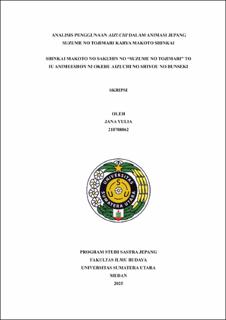Analisis Penggunaan Aizuchi dalam Animasi Jepang Suzume No Tojimari Karya Makoto Shinkai
Analysis of the Use of Aizuchi in the Japanese Animation Suzume No Tojimari by Makoto Shinkai
Abstract
This study examines the types and functions of aizuchi found in the Japanese animated film Suzume no Tojimari through a pragmatic approach. Aizuchi refers to verbal or non-verbal responses that frequently appear in daily conversations among Japanese speakers as indicators that the listener is paying attention, understanding, and following the conversation. The method employed is descriptive qualitative, with analytical steps consisting of identification, classification, and interpretation of meanings, as well as data analysis to identify the types and functions of aizuchi.
The findings reveal two main categories of aizuchi: aizuchi shi (responses in the form of words) and aizuchi-tekina hyougen (responses in the form of expressions). Aizuchi shi includes four types: outoushi (direct responses), sou-kei (indicating understanding), kantan-shi (expressing exclamations), and shuujoshi (sentence-final particles). Meanwhile, aizuchi-tekina hyougen consists of two types: fukushi (adverbs used to respond) and doushi (verbs used to respond). In terms of function, several communication signals were identified, including: kiiteiru to iu shingou (signals of listening), rikai shiteiru to iu shingou (signals of understanding), kanjou no shingou (signals of expressing emotion), and ma wo motaseru shingou (signals for filling pauses). The use of aizuchi in the data demonstrates how Japanese speakers interact to maintain smooth communication, serving as signals of attentiveness and comprehension toward the speaker’s message.
Collections
- Undergraduate Theses [593]

